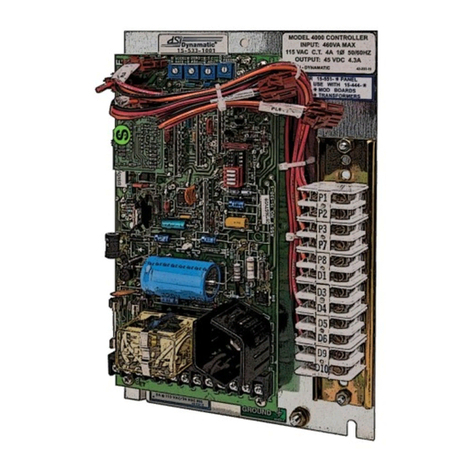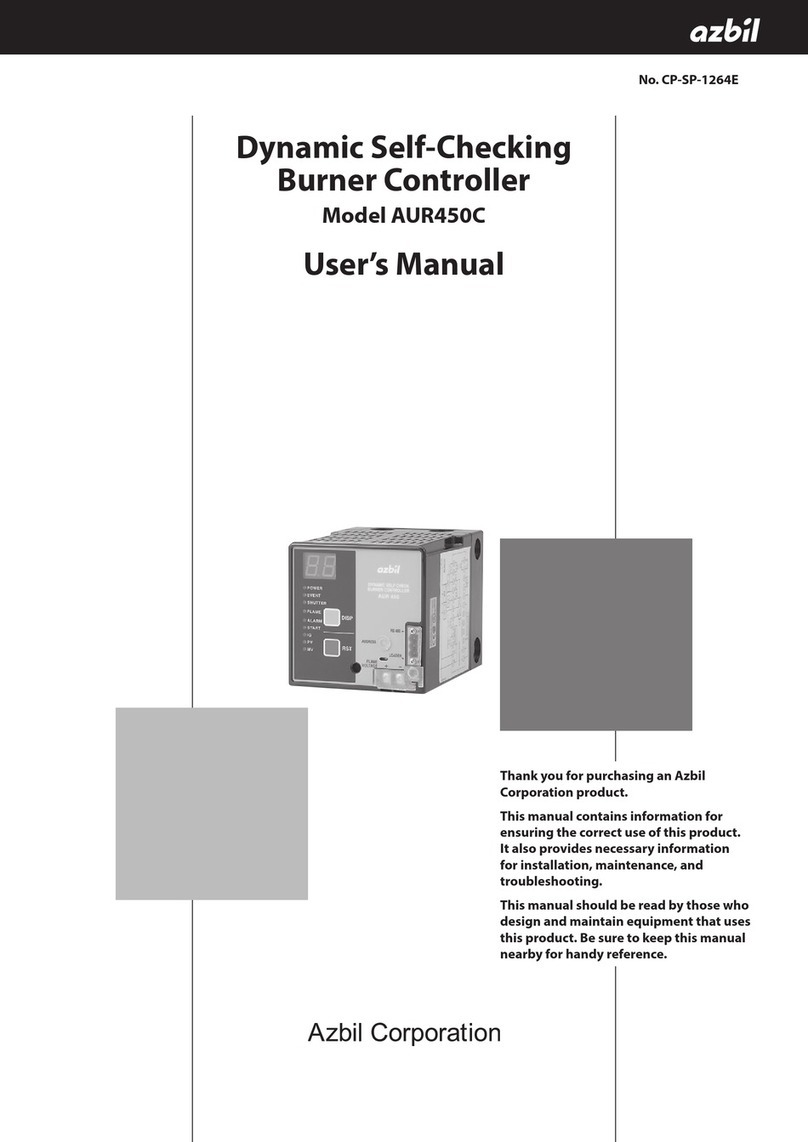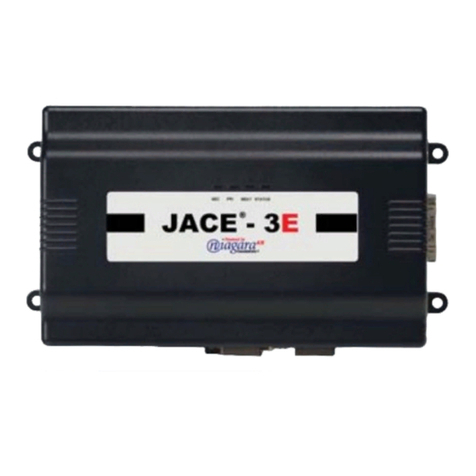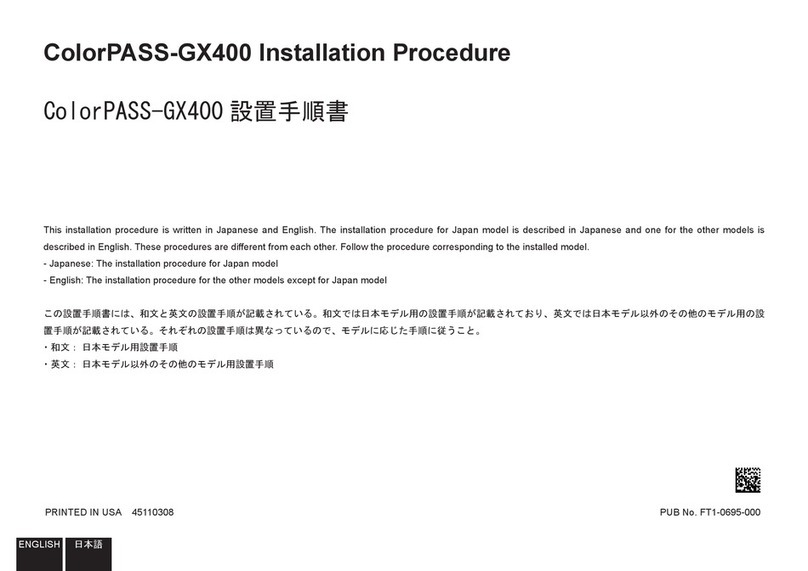Sifam Tinsley ST 301 ATS User manual

Page 1/44
GENSET CONTROLLER
Automatic Transfer Switch
Instruction Manual
ST 301 ATS

Page 2/44
INDEX
1- GENERAL REQUIREMENTS AND INSTALLATION ...................................................................................................................... 3
1- 1 General notes....................................................................................................................................................................................................... 3
1- 2 Dimensions........................................................................................................................................................................................................... 3
1- 3 Hardware ratings................................................................................................................................................................................................. 4
1- 4 Electrical Installations........................................................................................................................................................................................ 5
1- 4.1 Drawing....................................................................................................................................................................................................................................................5
1- 4.2 Connections............................................................................................................................................................................................................................................6
1- 5 Operation modes................................................................................................................................................................................................ 7
1- 5.1 Automatic mode....................................................................................................................................................................................................................................7
1- 5.2 Manual mode..........................................................................................................................................................................................................................................7
1- 5.3 Reset mode.............................................................................................................................................................................................................................................7
1- 5.4 Test mode................................................................................................................................................................................................................................................7
1- 5.5 Alarms.......................................................................................................................................................................................................................................................7
1- 6 Equipment Overview.......................................................................................................................................................................................... 8
1- 7 Display pages....................................................................................................................................................................................................... 9
1- 7.1 Navigation diagram..............................................................................................................................................................................................................................9
1- 7.2 Navigation cursors and first activation.......................................................................................................................................................................................10
1- 7.3 Display pages - Mains.......................................................................................................................................................................................................................11
1- 7.4 Display pages - Genset.....................................................................................................................................................................................................................11
1- 7.5 Display pages - Engine.....................................................................................................................................................................................................................12
1- 7.6 Display pages - Hours.......................................................................................................................................................................................................................12
1- 7.7 Display pages - Events log..............................................................................................................................................................................................................12
1- 7.8 Display pages - System....................................................................................................................................................................................................................12
1- 7.9 Clock and warranty.............................................................................................................................................................................................................................13
1- 8 Connection via RS485 with Genset controller............................................................................................................................................ 14
2- PROGRAMMING MENUS.................................................................................................................................................................. 15
2- 1 Navigation chart - Global Setup..................................................................................................................................................................... 15
2- 2 Navigation instructions................................................................................................................................................................................... 16
2- 3 M1 - Mains setup................................................................................................................................................................................................ 17
2- 4 M2 - Alternator setup........................................................................................................................................................................................ 18
2- 5 M3 - Engine setup.............................................................................................................................................................................................. 19
2- 6 M4 - General setup............................................................................................................................................................................................ 20
2- 6.1 M4.1 - Display setup..........................................................................................................................................................................................................................20
2- 6.2 M4.2 - Clock setup..............................................................................................................................................................................................................................20
2- 6.3 M4.3 - Test setup.................................................................................................................................................................................................................................21
2- 6.4 M4.4 - Security setup.........................................................................................................................................................................................................................22
2- 7 M5 - Alarms list.................................................................................................................................................................................................. 23
2- 7.1 M5 - Alarms default parameters....................................................................................................................................................................................................24
2- 7.2 M5 - Alarms description...................................................................................................................................................................................................................25
2- 8 M6 - Special functions...................................................................................................................................................................................... 26
2- 8.1 M6.1 - EJP..............................................................................................................................................................................................................................................26
2- 8.2 M6.2 - Start by mains kW.................................................................................................................................................................................................................27
2- 8.3 M6.3 - Dummy load.............................................................................................................................................................................................................................27
2- 8.4 M6.4 - TPS.............................................................................................................................................................................................................................................28
2- 8.5 M6.5 - Hours..........................................................................................................................................................................................................................................28
2- 9 M7 - Connectivity............................................................................................................................................................................................... 29
2- 9.1 M7.1 - Serial port setup.....................................................................................................................................................................................................................29
2- 9.2 M7.2 - GSM Setup...............................................................................................................................................................................................................................30
2- 9.3 M7.3 - Datalogger................................................................................................................................................................................................................................33
2- 10 M8 - IO setup.................................................................................................................................................................................................... 34
2- 10.1 M8.1 - Input setup.............................................................................................................................................................................................................................34
2- 10.2 M8.2 - Output setup.........................................................................................................................................................................................................................35
2- 10.3 M8.3 - Input type...............................................................................................................................................................................................................................37
2- 10.4 M8.4 - Output type............................................................................................................................................................................................................................37
2- 10.5 M8.5 - Calibration.............................................................................................................................................................................................................................37
2- 10.6 M8.6 - Expansion..............................................................................................................................................................................................................................38
2- 11 - Modbus RTU................................................................................................................................................................................................... 39
2- 11.1 General notes....................................................................................................................................................................................................................................39
2- 11.2 Genset Controller Configuration.................................................................................................................................................................................................39
2- 11.3 Modbus commands available......................................................................................................................................................................................................39

Page 3/44
1- GENERAL REQUIREMENTS AND INSTALLATION
1- 1 General notes
WARNING!
Carefully read the manual before the installation or use.
This equipment is to be installed by qualified personnel, complying to current standards, to avoid damages or safety hazards.
Before any maintenance operation on the device, remove all the voltages from measuring and supply inputs.
Products illustrated herein are subject to alteration and changes without prior notice.
Technical data and descriptions in the documentation are accurate, to the best of our knowledge, but no liabilities for errors, omissions or
contingencies arising there from are accepted.
A circuit breaker must be included in the electrical installation of the building. It must be installed close by the equipment and within easy reach
of the operator. It must be marked as the disconnecting device of the equipment: IEC /EN 61010-1 § 6.12.2.1.
Clean the instrument with a soft dry cloth; do not use abrasives, liquid detergents or solvents.
1- 2 Dimensions
Genset cut-offdimensions and its total dimensions are as shown below.
NOTE!
Inform the manufacturer the general identification data reported on the label, before asking for technical
specifications or information about the equipment.
182 mm
245 mm
40 mm
Cut-offdimensions:
220 x 160 mm

Page 4/44
1- 3 Hardware ratings
GENERAL CHARACTERISTICS
Rated voltage Vdc 12Vdc (24Vdc)
Allowed Vdc from 6Vdc to 33Vdc
Rated voltage Vac 400 Vac
Allowed Vac Up to 500 Vac
Allowed frequency From 45 to 75 Hz
Max consumption with backlight 250 mA
Temperature range
-30 °C + 70 °C (electric)
-20 °C + 70 °C (display)
-40 °C + 70 °C (storage)
DISPLAY 128x64 px ; 66x33mm
DIGITAL INPUTS
N° 5
STATIC OUTPUT
N° 6 (2x4A ; 4x2A)
SERIAL COMMUNICATION INTERFACE
Interface type Serial RS -232
Cable length < 3 m
Baud rate Up to 115200 bps
Interface type Serial RS485
Baud rate Up to 115200 bps
CONTACTORS RELAYS
N° outputs 2
Type of contacts 1x N.O. genset contactor - 1x N.C. mains contactor
Contatcs capacity 8 A / 250 VAC
LOAD CURRENTS INPUT
N° 3
Measure range Up to 5A
VOLTAGE INPUTS
N° 8
Input type Resistive coupling
Rated voltage 230 Vac (L-N) - 400 Vac (L-L)
Measure range TRMS from 0 to 300 Vac (L-N) - from 0 to 500 Vac (L-L)
ACTIVE POWER MEASURE
Measure type Instant power integration
HARDWARE
N°Keys 13
N°LED 10
STANDARD REFERENCE
EN55011
EN55016-2-1
EN55016-2-3
EN60068-2-1
EN60068-2-2
EN60068-2-27
EN60068-2-30
EN60068-2-6
EN61000-4-2
EN61000-4-3
EN61000-4-4
EN61000-4-5
EN61000-4-6
EN61000-4-8
EN61000-6-2
EN61000-6-4
HBV Bureau Veritas NR320

Page 5/44
1- 4 Electrical Installations
1- 4.1 Drawing
Warning! Before inserting the plugs and supply the board, make sure that the connections strictly comply with the wiring
diagram below.

Page 6/44
1- 4.2 Connections
J1 – Genset AC voltage and contactors
1.1 - Mains contactor output (NC)
1.2 - Mains contactor output (NC)
1.3 - Genset contactor output (NO)
1.4 - Genset contactor output (NO)
1.5 - Genset voltage phase 1
1.6 - Genset voltage phase 2
1.7 - Genset voltage phase 3
1.8 - Neutral
J2 – Mains AC voltage
2.1 - Mains voltage phase 1
2.2 - Mains voltage phase 2
2.3 - Mains voltage phase 3
2.4 - Neutral
J5 – Supply and Outputs
5.1 - Battery negative
5.2 - Battery positive
5.3 - Common positive for the relay outputs
5.4 - Programmable output (default – Start)
5.5 - Programmable output (default – Faulty start)
5.6 - Not used
5.7 - Not used
5.8 - Programmable output (default – Global alarm #1)
5.9 - Programmable output (default – Auto mode)
5.10 - Programmable output (default – Manual mode)
5.11 - Programmable output (default – Siren)
RS232 - Communication ports
RS232 - connection of a remote device
J8 - RS485 port
1- Shield
2- A
3- B
4- Termination resistor
J3 – Genset AC current
3.1 - Genset current I1
3.2 - Genset current I2
3.3 - Genset current I3
3.4 - CT common
J4 – Digital inputs
4.1 - Gnd
4.2 - Gnd
4.3 - Gnd
4.4 - Programmable digital input (default – Electrical Trip)
4.5 - Programmable digital input (default – Ground protection)
4.6 - Programmable digital input (default – Remote start)
4.7 - Programmable digital input (default – Remote stop)
4.8 - Programmable digital input (default – Ext. GE protection)

Page 7/44
1- 5 Operation modes
At the power on, the Genset is in reset mode. With the buttons you can choose the functioning mode you prefer.
1- 5.1 Automatic mode
Push the AUT button to select this functioning mode.
In case of mains failure the remote start output (J5.4) is activated and is de-activated in the presence of the same. This is the standard logic. It’s
also possible to activate the remote start output in special conditions. For more information see the special functions menu M6.
1- 5.2 Manual mode
In this operative mode, to turn-on the generator (activating the remote start output) you must press KG button. With engine running, you can
manually command the transfer switching with KG and KR buttons. KR, besides transferring the load on mains side, turns off the generator.
Pressing and releasing quickly the KR button, KG is opened and the remote start output is deactivated after the cooling time; keeping pressed for 3
seconds KR button, KG is opened and the generator is stopped immediately.
1- 5.3 Reset mode
The remote start output cannot be activated. If the mains is available it is connected to the load. If you select Reset mode, the alarms are reset and
the remote start output is deactivated. If the cause of the alarm remains, the cause is still present. Push the RESET button to select this functioning
mode.
1- 5.4 Test mode
Manual test: Press the TEST button: the remote start output is activated to test the genset for a programmable time.
a) If activated during MAN mode, the load switching can be controlled only by KG and KR buttons, even if the mains is faulty. Disabling the test (or
after the test time), the controller returns to the previous operation mode.
b) If activated during the AUT mode, the test can be made with or without load, depending on the programming of the test setup (see menu M4.3).
Automatic test: If you programmed an automatic test (see menu M4.3), it will run only if you are in automatic mode. The test can be made with or
without load, depending on the programming of the test setup (see menu M4.3).
1- 5.5 Alarms
In case of alarm, the display shows its description. If more different alarms are detected, they appear individually in sequence. For each alarm it is
available a message that can help to identify the source of the problem. The alarm reset can be made by pressing the RESET button; by this, the
alarm is deleted and the genset goes in Reset mode, preventing accidental generator starting attempts. If the alarm, after reset, still remains on the
display, the cause of the alarm is not removed.

Page 8/44
1- 6 Equipment Overview
POS. NAME DESCRIPTION
A Display Backlighted display that shows all functions, measures and alarms about the generator and the mains.
Automatically the backlight turns off, and it turns on again when you press a button.
B AUT Button to select the automatic mode.
C TEST Button to select the test mode.
D RESET To activate reset/OFF mode. In this operative mode the remote start output is deactivated and the alarms
are deleted. If the cause of the alarm persists, the alarm will appear again.
E KG Key control to activate the remote start output (only in manual mode). With engine running, and in manual
test mode, this button permits to manage the generator contactor.
F Menu To enter the programmation menu. Inside the menus, it’s used as a button “back” or “esc”.
G KG state led Led that indicates if KG is closed (led on) or open (led off).
H KR state led Led that indicates if KR is closed (led on) or open (led off).
I Help From the main page of the menu, it permits to go directly to the active alarms page, if at least one alarm is
present.
J KR
Key control to deactivate the remote start output (only in manual mode). If it’s pressed and released
quickly, it deactivates the output after the cooling time; if it’s pressed for 3 seconds, it deactivates the
output immediately. In manual test mode, this button permits to manage the mains contactor.
K MAN Button to select the manual mode.
L Navigation drive
Navigation drive composed by 4 arrows to scroll through the pages (left and right arrows) and increase or
decrease the parameters inside the programmation menus. It contains also a special button “i”, to select
an element on the screen or edit a parameter and confirm the new value. See paragraph 1.8.1 for more
information about the navigation of the display pages, and paragraph 2-2 for more information about the
navigation through the menus.
M Mains state led
It shows if the mains status:
led OFF if mains not detected
led blinking if mains detected outside limits
led ON if mains is within limits after delay
N Generator state led
It shows the status of the generator:
led OFF if genset is not detected
led blinking if genset is running but not within limits
led ON if genset is within limits after delay
O General alarm led It blinks if a stopping alarm is present. It remains ON if an alarm enabled as global alarm 1 is present.
P Battery state led It turns on when the board is supplied.
B
A
D
E
K
C
GF J
I
H
L
M
N
O
P

Page 9/44
1- 7 Display pages
1- 7.1 Navigation diagram
When you turn on the board, you will see the logo page. Then you will be in the mains stand-by page. When you start the generator, you will go in
the genset stand-by page. When you stop the engine you will return automatically to the mains stand-by page. With the left and right arrows, you
can move through the different sections, and with the up and down arrows you can scroll the pages of the selected section. Pressing the “i” button
from navigation pages, you can go to the status and alarm page. Here you can see the organization diagram of the display pages.
Notes:
Pages Mains 1,2,3,4 are shown only if parameter M in menu M1 is set to
“Three-phase”.
Pages Genset 1,2,3,4 are shown only if parameter M in menu M2 is set to
“Three-phase”.
Page Engine is shown only if the communication with genset is enabled inside
menu M7.1
START
DOWN
ARROW
Logo
ON
5 sec
STOP
MAINS 1 GENSET 1
HOURS EVENTS I/O
DIGITAL
MAINS 2
MAINS 3
MAINS 4
kWh
GENSET 2
GENSET 3
GENSET 4
kWh
I/O
ANALOG
DATASYS
Generator
OK
STARTING
Stop OK
STOPPING
MAINS
STANDBY
i
LEFT ARROW
RIGHT ARROW
UP
ARROW
EXPANSION
INPUTS
EXPANSION
OUTPUTS
MAINS
STANDBY
GENSET
SUMMARY
ALARMS
CLOCK /
WARRANTY

Page 10/44
1- 7.2 Navigation cursors and first activation
The cursors on the upper side and left side of the display indicate the position of the page inside the navigation diagram: the left and right
arrows move the page along with horizontal cursor.
The left arrow button allows to return back to the previous section: in this case from the generator pages to the mains pages.
If the vertical cursor is available on display it’s possible to use up and down arrow buttons to see more pages for the section: in this case from
the mains measure #1 to mains measure #2.
With up arrow button you can return to the previous page of the section. Inside the main page there is also the horizontal cursor which means
that the left and right arrow buttons are available.
When the controller is activated for the first time, the language selection screen will appear. If a language different from “DEFAULT ” is selected,
this screen will not appear anymore at the next start up.

Page 11/44
1- 7.3 Display pages - Mains
1- 7.3.1 Mains stand-by
When you turn on the board, you will see the logo page. After 5
seconds you will be in this page, that is the stand-by page with
engine OFF:
A) Mains Vac voltage L1-L2 (or L1-N if the system is single-
phase)
B) Mains L1 current
C) Total kW on mains
D) Total kVA on mains
E) Total power factor
F) Mains frequency
1- 7.3.2 Mains 1
(shown only in case of 3-phase system)
A) Mains Vac voltages L1-L2-L3
B) Mains line voltages L1-L2-L3
C) Mains currents L1-L2-L3 and total
1- 7.3.3 Mains 2
(shown only in case of 3-phase system)
A) Mains apparent power L1-L2-L3 and total
B) Mains active power L1-L2-L3 and total
C) Mains reactive power L1-L2-L3 and total
1- 7.3.4 Mains 3
(shown only in case of 3-phase system)
A) Mains apparent power L1-L2-L3 and total
B) Mains active power L1-L2-L3 and total
C) Power factor L1-L2-L3 and total
1- 7.3.5 Mains 4
(shown only in case of 3-phase system)
A) Mains apparent power L1-L2-L3 and total
B) Mains reactive power L1-L2-L3 and total
C) Power factor L1-L2-L3 and total
1- 7.3.6 Mains control kWh
A) Total active energy supplied by mains
B) Total mains energy cost
C) Cost of each mains MWh
1- 7.4 Display pages - Genset
1- 7.4.1 Genset summary
A) Genset Vac voltage L1-L2 (or L1-N if the system is single-
phase)
B) Genset L1 current
C) Total kW on genset
D) Total kVA on genset
E) Total power factor
F) Genset frequency
1- 7.4.2 Genset 1
(shown only in case of 3-phase system)
A) Generator Vac voltages L1-L2-L3
B) Generator line voltages L1-L2-L3
C) Generator currents L1-L2-L3
A B C
D E F
A B C
A B C
A B C
A B C
A
B
C
A B C
D E F
A B C

Page 12/44
1- 7.4.3 Genset 2
(shown only in case of 3-phase system)
A) Generator apparent power L1-L2-L3 and total
B) Generator active power L1-L2-L3 and total
C) Generator reactive power L1-L2-L3 and total
1- 7.4.4 Genset 3
(shown only in case of 3-phase system)
A) Generator apparent power L1-L2-L3 and total
B) Generator active power L1-L2-L3 and total
C) Generator power factor L1-L2-L3 and total
1- 7.4.5 Genset 4
(shown only in case of 3-phase system)
A) Generator apparent power L1-L2-L3 and total
B) Generator reactive power L1-L2-L3 and total
C) Generator power factor L1-L2-L3 and total
1- 7.4.6 Genset control kWh
A) Total active energy supplied by generator (upgraded every
work hour with KG closed)
B) Total generator energy cost
C) Cost of each generator MWh
1- 7.5 Display pages - Engine
A) Total work hours of the generator
B) Battery voltage of the generator
C) Hours left to service
D) Oil pressure
E) Engine temperature
F) Fuel level percentage
Note: this page is shown only if parameter B inside menu M7.1 is
set to “Modbus Master” and parameter I is set to “On”.
1- 7.6 Display pages - Hours
A) Total work hours of the generator
B) Total work hours with KG closed and load > 0
C) Total work hours with KR closed and load > 0
1- 7.7 Display pages - Events log
The events log page shows you the last alarms with the date and
time.
A) First event inside selected page: each event records alarm ID,
alarm name, date and hour.
B) Second event inside selected page.
C) Press the UP or DOWN button to select the up or down arrow,
then press “ I ”. This way you can scroll the events (up to 250).
1- 7.8 Display pages - System
1- 7.8.1 I/O digital
In this page you can see the state of all the 5 digital inputs (from J4.4
to J4.8) and outputs KG (J1.4), KR (J1.1), plus 6 programmable
outputs (from J5.8 to J5.11, J5.4 and J5.5).
1- 7.8.2 I/O analog
In this page you can see the state of 8 analog inputs (mains voltages
excluded).
A B C
A B C
A B C
A
B
C
A B C
D E F
A
BC
A
B
C

Page 13/44
1- 7.8.3 Expansion inputs
Here you can see the state of the 8 digital inputs of the expansion
board (only with expansion enabled).
1- 7.8.4 Expansion outputs
Here you can see the state of the 8 digital outputs of the expansion
board (only with expansion enabled).
1- 7.8.5 Data info
This page contains the the information about the release file:
REL: Project release version
FW: Firmware release version
SW: TE Utilities release version
DA: Release date
1- 7.9 Clock and warranty
A) Clock: date and time
B) Controller warranty expiry date detected automatically by
controller after 2 hours with mains voltage and frequency
within limits
A
B

Page 14/44
1- 8 Connection via RS485 with genset controller
It’s possible to connect the ATS with a genset controller via RS485. This way it’s possible to read the most important measures and
alarms directly by the ATS controller, and command the starting and stopping of the genset via RS485, without other external
connections.
The connection can be done following the drawing:

Page 15/44
2- PROGRAMMATION MENUS
2- 1 Navigation chart - Global Setup
Direct to
parameters
Direct to
parameters
M4.1 – Display
setup M4.2 – Clock
setup
M4.3 – Test
setup M4.4 – Setup
Security
Alarm
category setup
M7.1 – Serial
port setup M7.2 – GSM
setup
M8.1 – Input
setup M8.2 – Output
setup
M8.3 – Input
type M8.4 – Output
type
M8.5 -
Calibrations M8.6 –
Expansion
M6.1 – EJP
setup M6.2 – Start by
mains kW
M6.3 – Dummy
load M6.4 – Setup
TPS
M6.5 – Hour
counters
M7.3 -
Datalogger
Directly to
parameters

Page 16/44
2- 2 Navigation instructions
Entering global setup, pressing the MENU button, you have to insert the correct password to access to the programming menu. Press the DOWN
arrow to highlight the square with the password, and press “i” to confirm. Modify the password with the LEFT and RIGHT arrows, then confirm with
“i”. The password, by default, is 1. If you enter the wrong password, you will see the indication “wrong code” and you will not be able to enter inside
the menu. To change the password, see the Security setup, M.4.4.
If the password is correct, press the DOWN arrow to select the icon (A) and confirm with “i” to enter in the programming menus.
The correct password
is, by default, 1
Note: the password that you insert will
remain in memory until you turn-off the
controller.
From the main page you can choose 8 different menus:
A) Mains setup
B) Alternator setup
C) Engine setup
D) General setup
E) Alarms setup
F) Special functions
G) Connectivity
H) I/O setup
If the HELP symbol is present, it means that there is at least one alarm active. Pressing the HELP button, you directly go to the active alarms page.
With the arrows you can select the menu. Once selected the desired menu, press the “i” button to confirm and enter or press “menu” to return to the
previous screen. Then you will see a screen for the choice of the sub menu (except for Alternator, Mains and Alarms, in which you will see directly
the programming parameters). This screen is composed by 3 parts:
A) The name of the submenu
B) The icon of the submenu
C) The page and the icon of the menu that contains the submenu
Press “i” to confirm and enter, or press the left or right arrows to see the next submenu, or press “menu” to return to the previous screen. In the
submenus, the parameters are divided in different pages; choose the page with the left and right arrows, and choose the parameter with the up and
down arrows. Then press “i” to confirm and modify the parameter. Then press “i” to confirm or “menu” to cancel.
A
B
C
A
B
C
D
E
F
G
H
A

Page 17/44
2- 3 M1 - Mains setup
POS. NAME DESCRIPTION RANGE OF
VALUES
DEFAULT
SETTINGS
A Mains rated V Allows you to set the rated voltage of the mains. 0-600 [Vac] 400
B Mains high V
You can set the high threshold voltage; if the voltage measured is
higher than this value (% of the rated voltage), the mains is considered
faulty and Genset starts the generator (in automatic mode).
100-200 [%] 115
C Mains low V
You can set the low threshold voltage; if the voltage measured is lower
than this value (% of the rated voltage), the mains is considered faulty
and Genset starts the generator (in automatic mode).
0-100 [%] 85
D Mains rated F Allows you to set the rated frequency. 50-60 [Hz] 50
E Mains high F
You can set the high frequency threshold; if the frequency measured is
higher than this value (% of the rated frequency), the mains is
considered faulty and Genset starts the generator (in automatic mode).
100-200 [%] 110
F Mains low F
You can set the low frequency threshold; if the frequency measured is
lower than this value (% of the rated frequency), the mains is
considered faulty and Genset starts the generator (in automatic mode).
0-100 [%] 90
G KR delay
You can set a delay time for the closure of the mains contactor. This
time starts from when the Genset
opens the generator contactor (software interlock function).
0-100 [s] 1
H Mains OK
It is the delay time after which, if the mains returns within the limits set
(see parameters B, C, E, F), it’s considered stable and the mains
contactor is closed, then begins the stop phase of the generator (in
automatic mode).
0-600 [s] 10
I Faulty mains
It is the delay time after which the mains is considered faulty, compared
with the limits specified in parameters B, C, E, F. This parameter is
used to filter any temporary instability of the mains. Increase this
parameter to avoid fast start/stop procedures due to mains flickering.
0-600 [s] 5
J Phase sequence Choose the sequence of the phases: R-S-T or T-S-R, or OFF OFF-RST-TSR RST
K V Asymmetry If the difference between the lower and the higher phase voltages is
greater than this parameter, the asymmetry alarm (if enabled) is shown. 0-100 [%] 10
L KR protection
Parameter to enable the protection on mains failure. If On, the alarms
about the mains immediately open the mains contactor. If Off, the
mains contactor is opened only when the generator is ready.
On-OffOn
M System type You can set the type of system of the mains: three-phase, single-phase
or two-phase with neutral.
Three-phase
Single-phase
Two-phase+n
Three-phase
N Cost for MWh Set the cost for every Mega Watt per hour supplied by mains 1-999999 210
O Start by KR
If On, if parameter “KR protection” is set to ON, every condition which
activates KR protection (phase inversion, feedback KR, asymmetry
alarm, etc...) also triggers an engine start with changeover on generator
until the mains returns ok.
On-OffOn

Page 18/44
2- 4 M2 - Alternator setup
POS. NAME DESCRIPTION RANGE OF
VALUES
DEFAULT
SETTINGS
A GE rated V Rated voltage of the generator. 0-600 [VAC] 400
B GE high V
You can set the high threshold voltage; if the voltage measured is higher than
this value (% of the rated voltage), the generator is considered faulty and
Genset shows the “high GE voltage” alarm.
100-200 [%] 115
C GE low V
You can set the low threshold voltage; if the voltage measured is lower than
this value (% of the rated voltage), the generator is considered faulty and
Genset shows the “low GE voltage” alarm.
0-100 [%] 85
D GE rated F Rated frequency of the generator. 40-70 [Hz] 50
E GE high F
You can set the high threshold frequency; if the frequency measured is higher
than this value (% of the rated frequency), the generator is considered faulty
and Genset shows the “high GE frequency alarm”.
100-200 [%] 110
F GE low F
You can set the low threshold frequency; if the frequency measured is lower
than this value (% of the rated frequency), the generator is considered faulty
and Genset shows the “low GE frequency alarm”.
0-100 [%] 90
G Rated current You set the nominal operating current of the generator. 0-9999 [A] 100
H Imax overload You set the maximum overload admitted on the generator. If exceeded, an
alarm message is shown. 0-1000 [%] 200
I Imax short circuit You set the value that permits to consider a short circuit on the generator. If
exceeded, related alarm message is shown. 0-1000 [%] 300
J KG delay
You can set a delay time for closing the generator contactor.This time starts
from when the Genset opens the mains contactor (software interlock
function).
0-100 [s] 1
K GE Ok delay
It is the delay time over which if the voltage and frequency are within limits
(parameters B, C, E, F), the generator is considered stable and its contactor
is closed.
0-65535 [s] 5
L CT ratio It sets the ratio of Current Transformers to read the current value (example:
CT 100/5A, you must set it at 20, because 100: 5 = 20). 0-10000 20
M System type You can set the type of system of the generator: three-phase, single-phase or
two-phase with neutral.
Three-phase
Single-phase
Two-phase+n
Three-phase
N Set kWh Here you can set the initial value of the kWh. 0-10E+8 [kWh] 0
O Phase sequence Choose the sequence of the phases: R-S-T or T-S-R, or OFF OFF-RST-TSR RST
P Asymmetry If the difference between the lower and the higher phase voltages is greater
than this value, the asimmetry alarm (if enabled) is shown. 0-100 [%] 10
Q GE Filter
Insert a 5-levels software filter on eventual disturbs on generator voltage and
frequency. It can be set from 0 (no flitering) to 5 (high filtering), to avoid
accidental opening of the generator contactor.
0-5 1
R Neutral Set if the system is with (On) or without (Off) neutral. On-OffOn
S Single CT
If On, line 2 and line 3 load currents are the same value of line 1. In this case
it is possible to calculate all 3-phase load measurements (kW, kVA, kVAR,
PF) using a single current transformer. This feature is intended to be used
only with balanced three-phase loads.
On-OffOff
T Cost for MWh Set the cost for every Mega Watt per hour supplied by the generator. 1-999999 350

Page 19/44
2- 5 M3 - Engine setup
POS. NAME DESCRIPTION RANGE OF
VALUES
DEFAULT
SETTINGS
A ON alarm delay
It is the time delay from the engine running detection to the enable of the
alarms; this time allows the generator to reach the nominal operating
conditions.
0-1000 [s] 8
B Cooling time
It sets the cooling time after which the engine is stopped: after the
generator contactor opening, the remote start output remains active for the
set time, to cool down without load. It works only in automatic mode.
0-255 [s] 1
C Siren time It is the duration time of the acoustic advisor in case of alarm, if a
programmable output is set for “Siren”. 0-1000 [s] 20
NOTES:
To avoid any incompatibility between the timings of the ATS and the controller for engine protection, remember that the “ON alarm
delay” must be at least 5 seconds higher than the preheat time in the engine protection controller.
The cooling procedure is managed by the ATS. If the engine protection controller allows to set a cooling procedure, we advise to disable
it and maintain active only the procedure on the ATS controller.

Page 20/44
2- 6 M4 - General setup
The general setup is composed by 4 submenus:
A) Display setup: Submenu that contains all the parameters settings of the screen: language, contrast, etc
B) Clock setup: Submenu with the general settings about the clock: date, time and day of the week
C) Test setup: Submenu with the settings of the test operation mode, like the length and day of the programmable tests
D) Security setup: Submenu to set the passwords for different levels that lock and unlock the various menus
2- 6.1 M4.1 - Display setup
POS. NAME DESCRIPTION RANGE OF
VALUES
DEFAULT
SETTINGS
A Language
You select the language. On board are available the following languages:
English, Italian and French. Another language can be inserted by request in
the “custom” position. The controller at the turn-on will ask the settings of the
language only if the “default” option is selected.
IT – EN –
FR –
Custom –
Default
Default (EN)
B Contrast To set the display contrast preferred for the Genset. 0-15 10
C Show warranty If On the automatic controller warranty time will be shown on display,
otherwise it will remain hidden. Off-On On
D Show IO If On the IO monitor pages will be shown on display, otherwise they will
remain hidden. Off-On On
2- 6.2 M4.2 - Clock setup
POS. NAME DESCRIPTION RANGE OF
VALUES
DEFAULT
SETTINGS
- Set clock
Used to confirm the adjusted date/clock, it updates the current time with the
values set in parameters A,B,C,D,E,F. To do it, you must select the area
using the drive arrows and then confirm by the “i” drive button.
- -
- Current setting It shows current date and clock set. - -
A Year To set the year 0-99 13
B Month To set the month 0-12 1
C Day To set the day 0-31 1
D Day of the week To set the day of the week from Sunday to Saturday Sun - Sat Sun
E Hours To set the current hour 0-23 12
F Minutes To set the current minute 0-59 0
Table of contents
Popular Controllers manuals by other brands

Traxon
Traxon Butler S2 Setup manual
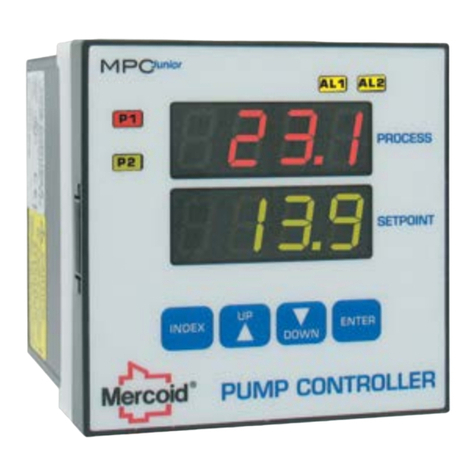
Mercoid
Mercoid MPCJR Series Specifications-installation and operating instructions

Emerson
Emerson Tescom 44-6800 Series Operation & service manual

Redarc
Redarc Tow-Pro EBRH-ACCNA manual
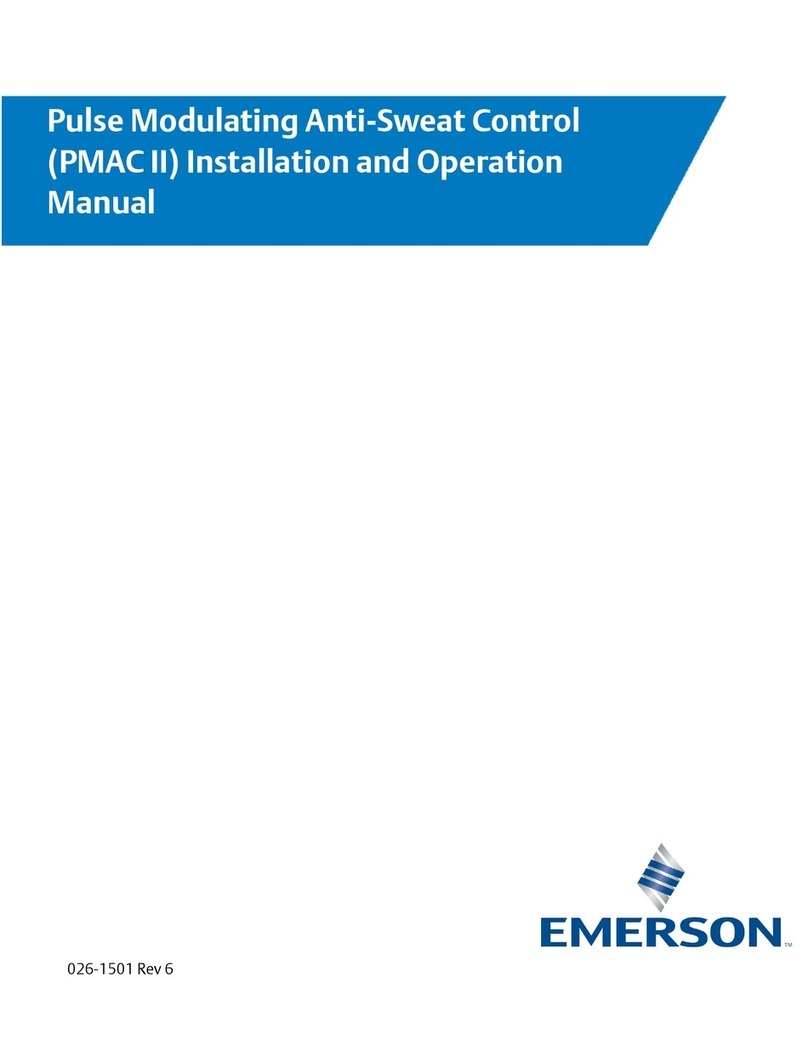
Emerson
Emerson PMAC II Installation and operation manual

Festo Pneumatic
Festo Pneumatic SDK-3-PK-3 operating instructions
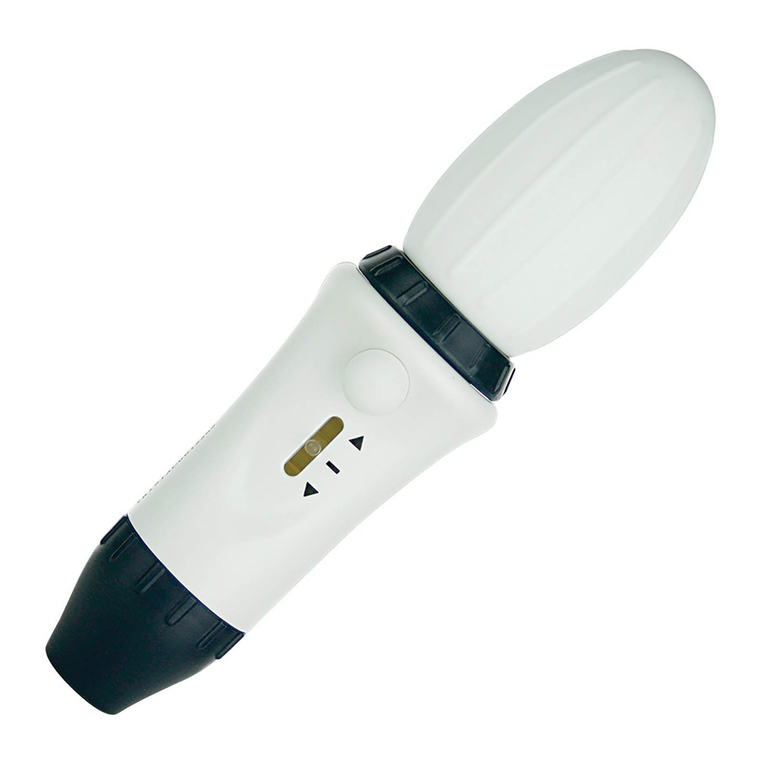
Globe
Globe 3375 user manual
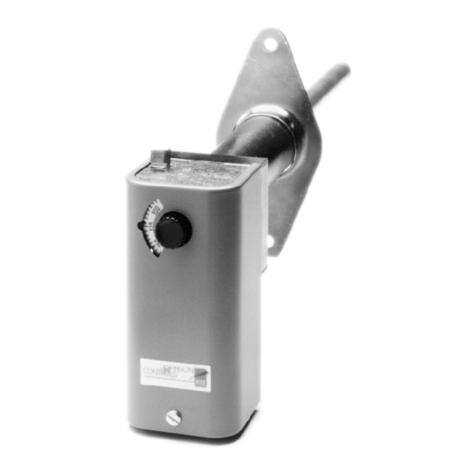
Johnson Controls
Johnson Controls A25 Series Technical bulletin
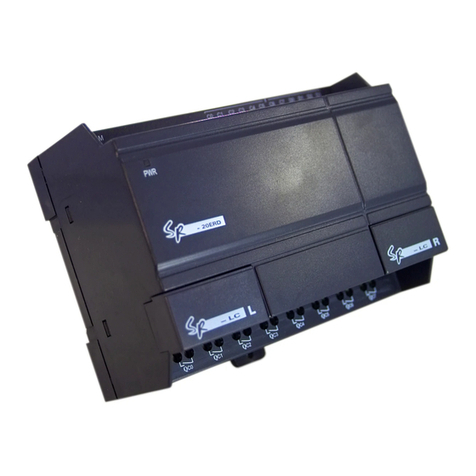
Array electronic
Array electronic SR Series manual
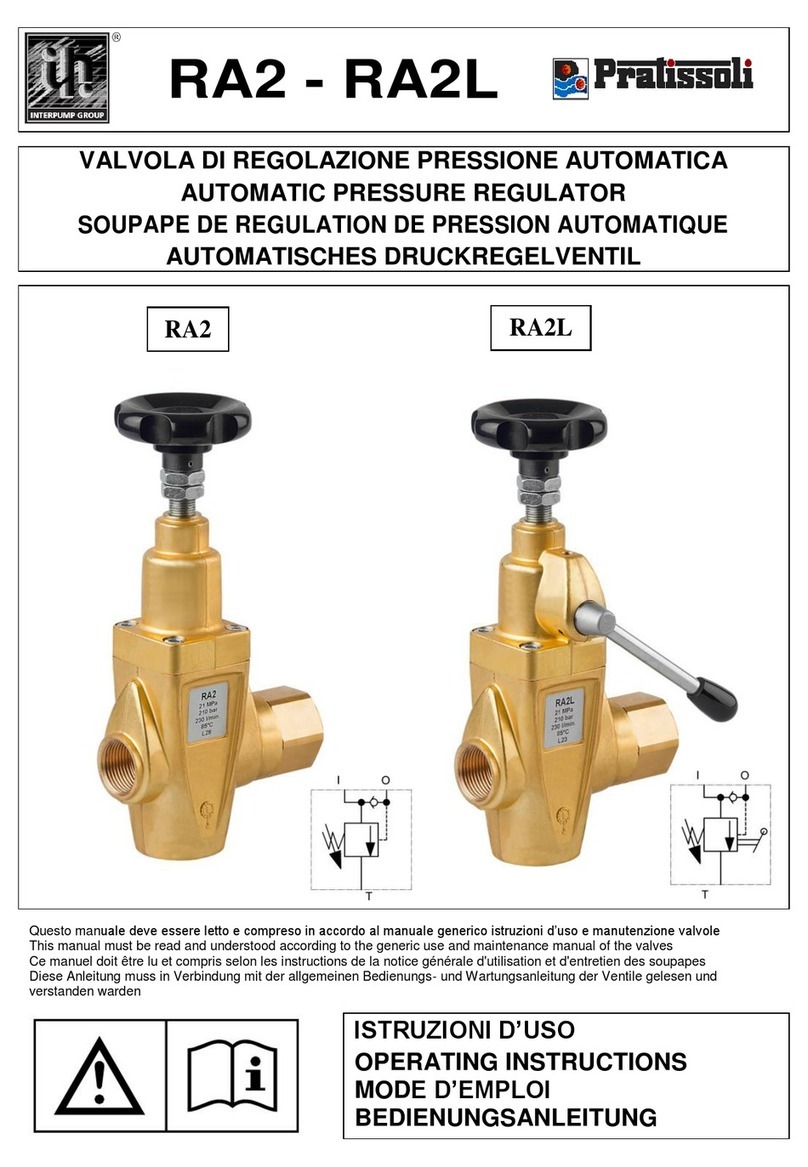
Interpump Group
Interpump Group Pratissoli RA2 operating instructions
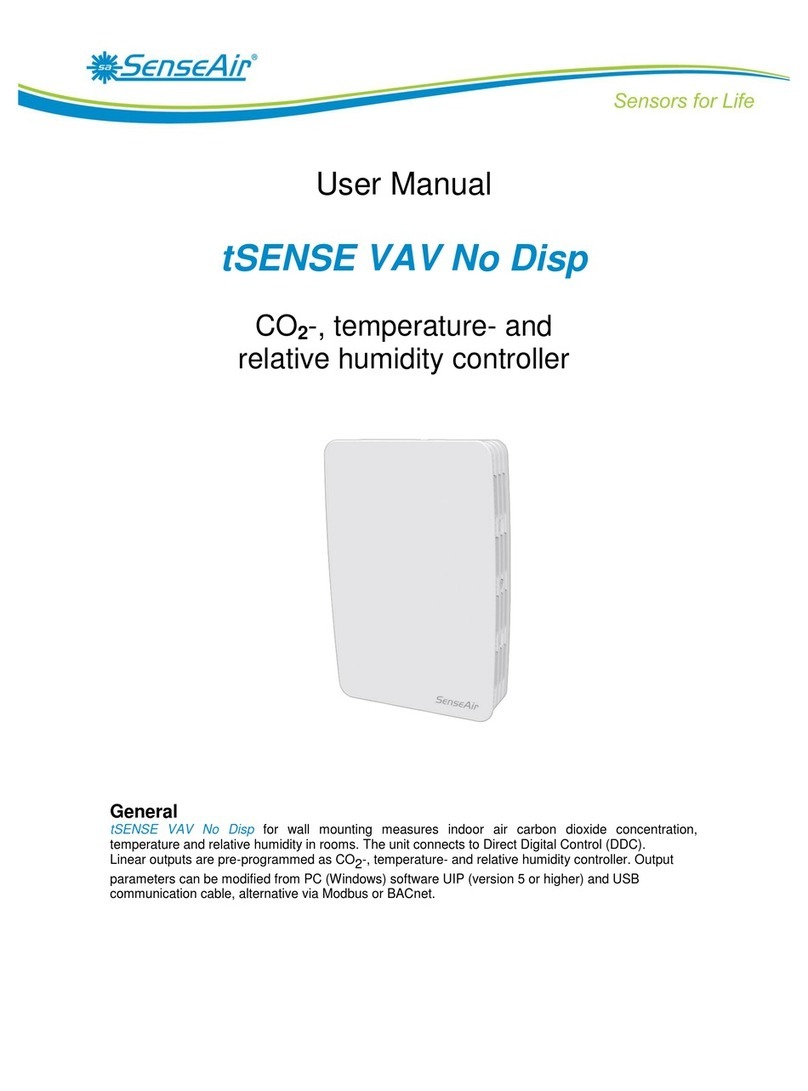
SenseAir
SenseAir tSENSE VAV No Disp user manual
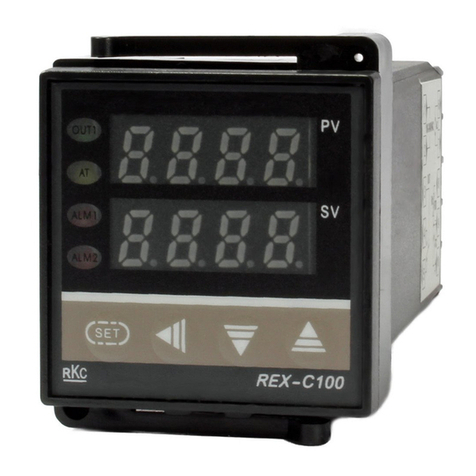
RKC INSTRUMENT
RKC INSTRUMENT REX - C100 INITIAL SETTING MANUAL
